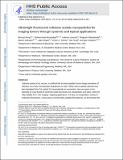Ultrabright fluorescent cellulose acetate nanoparticles for imaging tumors through systemic and topical applications
Author(s)
Peng, Berney; Almeqdadi, Mohammad; Roper, Jatin; Yilmaz, Omer; Sokolov, Igor
DownloadAccepted version (1.521Mb)
Publisher with Creative Commons License
Publisher with Creative Commons License
Creative Commons Attribution
Terms of use
Metadata
Show full item recordAbstract
Cellulose acetate (CA), viscose, or artificial silk are biocompatible human-benign derivatives of cellulose, one of the most abundant biopolymers on earth. While various optical materials have been developed from CA, optical CA nanomaterials are nonexistent. Here we report on the assembly of a new family of extremely bright fluorescent CA nanoparticles (CA-dots), which are fully suitable for in vivo imaging/targeting applications. CA-dots can encapsulate a variety of molecular fluorophores. Using various commercially available fluorophores, we demonstrate that the fluorescence of CA-dots can be tuned within the entire UV–VIS-NIR spectrum. We also demonstrate excellent specific targeting of tumors in vivo, when injected in zebrafish (xenograft model of human cervical epithelial cancer), and unusually strong exvivo topical labeling of colon cancer in mice utilizing CA folate-functionalized nanoparticles.
Date issued
2019-03Department
Massachusetts Institute of Technology. Department of Biological Engineering; Koch Institute for Integrative Cancer Research at MITJournal
Materials today
Publisher
Elsevier BV
Citation
Peng, Berney et al. “Ultrabright fluorescent cellulose acetate nanoparticles for imaging tumors through systemic and topical applications.” Materials today 23 (2019): 16-25 © 2019 The Author(s)
Version: Author's final manuscript
ISSN
1369-7021